Worthwhile Facts about:
"Gold Nuggets"
"Gold Specimen"
"Gold"
in general
Gold Nuggets are a very rare and in it’s quantity limited commodity. Despite the fact that a lot of Nuggets were found during the Gold Rushes of the 19th and 20th century by a vast number of hopeful Prospectors in many countries of the World, only very few of these exceptional Treasures of nature have survived until today. In a small number of cases we at least have some poor quality black and white Photographs that have survived the test of time, to remind us of some absolutely incredible once in a lifetime finds. Because in the early days a Nugget did not possess a premium value above its worth in Gold content, all but a few have been molten down and refined, to end up as Coins, Jewellery, Artefacts or Gold bars. Considering that a lot of these finds were made under very adverse conditions by people who needed to keep them self’s and their families alive in some of the most inhospitable places on earth, it is understandable that they did not have the luxury of getting sentimental about a lump of Gold. On top of that, it was at times illegal to privately own Gold apart from Coins and Jewellery in some countries, and it had to be sold after finding it. Only slowly did it become clear to some people, that a lot of irreplaceable Treasures of Mother Nature were being indiscriminately destroyed. Collectors, Museums, Geologists as well as Gold and Mineral Specimen enthusiasts all helped to gradually bring about a change to this practice.
But what makes Gold Nuggets so special anyway, apart from the fact
that they have an intrinsic value in relation to their actual Gold
content? Well, since less than about 2% of all the Gold ever found was
in the form of Nuggets and the vast majority of these were put in to
furnaces to be molten down and refined, it really makes them an
exceptionally scarce commodity. Trying to find a good Gold Nugget can be
like looking for the proverbial Needle in a Haystack. Then there is the
fact that this rare resource has been shaped over Millions of years in
to unique pieces of Jewellery by the forces of Nature. Every Nugget is
an absolute once off Treasure to be cherished for it’s exclusiveness.
Also, there is a interesting story behind almost every find that could
be worth hearing about.
Thanks to advances in the electronics of Metal Detectors over the last
15 – 20 years, there has been a marked increase of people who spend time
out on the old Goldfields again, in search of this elusive precious
metal. A modern day Gold Rush one might almost call it. But despite of
that, the amounts of Nuggets found remain very moderate and are on the
decline again. Regardless of that, some finds are still
being molten
down, to get the quick money. Bills have to be paid even if one lives
out in the Bush. But most Prospectors these days are aware of the fact
that destroying these rare jewels of Nature is tantamount to sin.
The same can be said about Gold that is still attached to it’s host
rock (Specimen).
These Specimen, have been exposed to the destructive forces of
Nature, by the natural weathering that has eroded away the surrounding
countryside over millions of years.
Most of the Specimens that survived the persistent attacks from the environment and were found by modern day Prospectors and Miners as well as the Old-timers from days gone by, were put trough “Stampers“ and ground to dust, in the endeavour to recover the Precious metal they contained. Most of the Gold bearing Ore that is being mined today, contains such minute amounts of this highly priced metal that it is not, or barely observable to the naked eye and hence not really sought after as a display piece by collectors. Attractive Gold Nuggets and good Specimen, containing a lot of visible Gold are exceedingly rare and becoming more so, as the easily accessible ground is getting worked out and good new finds are becoming scarcer. No wonder it is then, that they are being sold with a premium above their worth in Gold. Attractiveness, Size and usefulness as a Jewellery or display piece all have some bearing towards the end price. According to some people it is easier these days to find a 5ct. Diamond of good Quality than it is to find a one ounce Nugget.
Mother natures Treasure chest is not infinite, and this is reflected by the steadily declining availability of these natural Jewels.
Things worthwhile knowing about Gold
The list of Geo-chemical recurrence, lists Gold in 73rd place of 81 listed Elements. This makes Gold with the symbol “AU” (Short for the Latin Aurum) an exceedingly rare Element in nature. Throughout the earths crust it averages out at only about 0.0005g. per ton. Only through geological enriching of the host rock and secondary deposits, does it become feasible to mine it at viable costs. Gold has been very sought after as far back as the beginning of recorded history. Due to it’s scarcity, beautiful lustre, low melting point (about1064°C) and softness which made it easy to fashion in to Coins, Artefacts, and Jewellery that are enhanced by the metals natural and rare beauty, it was very early on already considered to be something of great value. In today’s age of Computers and Space travel, the usefulness of this precious metal has gone way beyond the manufacturing of trinkets, charms and ornaments. Aurum is one of the few pure elements in nature and because of it’s inherent stability and resistance to corrosion from air, water and acid, makes it incredibly useful indeed. It is very malleable and can be hammered into foil so thin as to become translucent without the side effect of developing brittleness. A cube of 1cm squares can be fashioned in to a sheet of foil with an average thickness of 0.00001cm which will cover an area of about 10 square meters.
The exceptionally high density of approximately 19 g/cm3 (Depending on impurities) has been a factor in Gold being concentrated through natural geological actions in secondary deposits, and it is also of great help to the Prospector, because it allows him to extract it by very basic means. The fact that it can be located by using Metal Detectors, is just an added advantage.
Below are listed a few helpful definitions of terms that are frequently encountered in connection with Gold.
Ounce (Troy): English measure of weight equalling 31.1g.
Specimen: Gold still attached to it’s host rock and / or other minerals.
Nugget: Naturally formed lump of Gold generally found in alluvial deposits.
Karat: Scale of precious metal content in an alloy. For example, 24Kt. = 99.9% / 18Kt. = 75%.
Gold Amalgam: Gold mixed with Mercury. Because Mercury is
attracted to, and absorbs Gold, it can be used to isolate very fine Gold
from other heavy minerals. To separate the two again, the Amalgam has to
be heated up in a Retort to evaporate the Mercury. Fatally dangerous
fumes are created in this process und it is not recommended without the
proper equipment and experience.
![]() It
can be extremely dangerous and should not be attempted.
It
can be extremely dangerous and should not be attempted.![]()
Various Deposits
Primary: Hard rock deposit. The Mineral mined is still in the host rock where it was formed.
Secondary: The Mineral mined has moved away from its place of origin through natural weathering and has been concentrated in Alluvium / Colluvium deposits.
Alluvium: Deposits created through natural weathering in connection with water. The Mineral concentrates away from its place of origin.
Coluvium: Deposits created through natural weathering in connection with gravity. Water does not play a major part. The Mineral concentrates away from its place of origin.
Eluvium: Deposits where the mineral remains “Insitu” (In it’s
original place) and only moves downward due to gravity and the removal of
the surrounding soils through natural weathering.

If you could not find what you
were looking
for, don't hesitate to contact us. We may just have what you desire.
| Gold-Nuggets |
 GN294 - 5.68g. 12.60mm x 11.00mm x 8.50mm CHF 340.80 |
 GN295 - 12.80g. 23.50mm x 17.00mm x 7.00mm CHF 1075.00 |
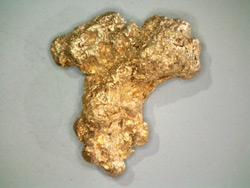 GN296 - 2.73g. 13.40mm x 11.50mm x 5.60mm CHF 218.40 |
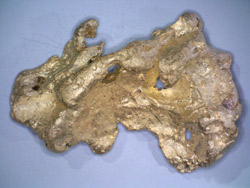 GN297 - 16.90g. GN297 - 16.90g.29.40mm x 19.60mm x 9.00mm CHF 1588.60 |
 GN298 - 0.25g. 7.50mm x 6.00mm x 1.40mm |
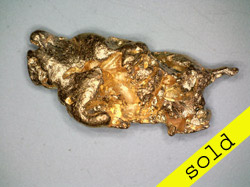 GN299 - 0.65g. 11.00mm x 5.10mm x 2.30mm |
 New GN302 - 1.40g. 9.00mm x 6.50mm x 5.50mm CHF 112.00 |
 New GN303 - 17.15g. 37.50mm x 17.00mm x 3.50mm CHF 1612.10 |
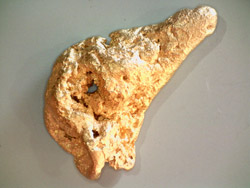 New GN307 - 11.90g. 26.90mm x 14.00mm x 6.00mm CHF 999.60 |
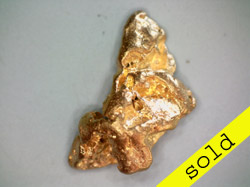 New GN308 - 0.62g. 8.80mm x 4.10mm x 3.70mm |
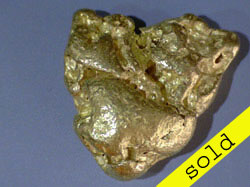 GN218 - 5.40g. 14.60mm x 12.50mm x 6.00mm |
 GN252 - 20.10g. 27.50mm x 21.00mm x 5.40mm |
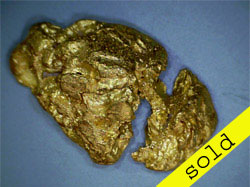 GN254 - 12.80g. 22.20mm x 14.00mm x 10.50mm |
 GN258 - 1.50g. 12.30mm x 7.30mm x 6.00mm CHF120.00 |
 GN263 - 1.85g. 17.00mm x 6.00mm x 4.00mm / Q |
 GN264 - 9.45g. 18.00mm x 17.40mm x 7.30mm |
 GN269 - 2.90g. 14.70mm x 8.00mm x 3.90mm |
 GN270 - 1.20g. 10.70mm x 8.20mm x 3.70mm CHF 96.00 |
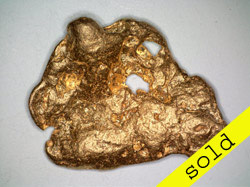 GN273 - 2.08g. 15.00mm x 11.90mm x 2.70mm |
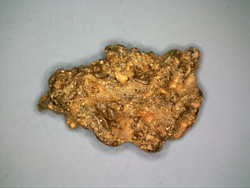 GN275 - 1.70g. 11.00mm x 8.50mm x 4.30mm CHF 136.00 |
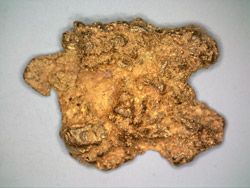 GN276 - 2.15g. 14.60mm x 11.00mm x 3.30mm CHF 172.00 |
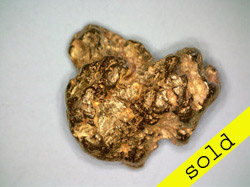 GN279 - 2.10g. 10.20mm x 8.70mm x 4.60mm |
 GN280 - 1.80g. 9.50mm x 8.70mm x 4.10mm / Q |
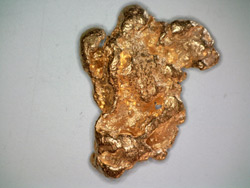 New! GN283 - 2.20g. 14.00mm x 11.50mm x 3.50mm CHF 176.00 |
 New! GN286 - 1.55g. 16.50mm x 7.50mm x 2.50mm CHF 124.00 |
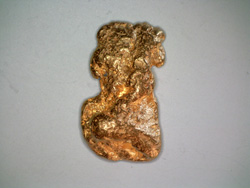 New! GN287 - 2.65g. 13.00mm x 7.80mm x 4.50mm CHF 212.00 |
 New! GN288 - 1.35g. 12.20mm x 8.60mm x 2.40mm CHF 108.00 |
 New! GN289 - 3.40g. 19.00mm x 10.50mm x 7.50mm CHF 190.40 |
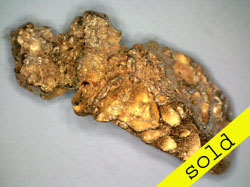 New! GN293 - 3.00g. 17.00mm x 7.00mm x 6.40mm CHF 168.00 |
 DP01 - 46.10g. 35.40mm X 24.50mm X 20.90mm CHF 4333.40 |
 GN040 - 28.90g. 26.00mm x 24.30mm x 8.90mm CHF 2716.60 |
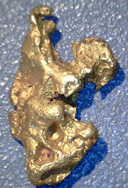 GN046 - 21.80g. 31.40mm x 19.40mm x 9.50mm CHF 2049.20 |
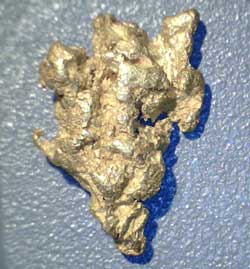 GN048 - 30.90g. 35.90mm X 24.46mm X 12.30mm CHF 2904.60 |
 GN051 - 51.00g. 35.00mm x 35.00mm x 8.70mm CHF 3570.00 |
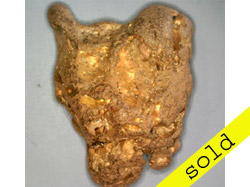 GN056 - 32.00g. 25.50mm X 20.00mm X 14.00mm |
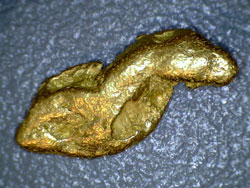 GN124 - 6.85g. 23.00mm x 10.00mm x 5.20mm CHF 548.00 |
 GN127 - 15.95g. 24.00mm x 18.20mm x 10.50mm CHF 1499.30 |
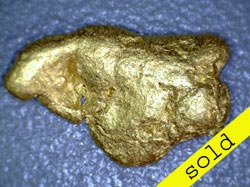 GN164 - 9.10g 21.60mm x 13.60mm x 5.00mm |
 GN165 - 20.35g. 32.50mm x 18.00mm x 9.00mm CHF 1912.90 |
 GN193 - 2.75g. 13.30mm x 6.90mm x 4.80mm CHF 220.00 |
| All above
information subject to change. Postage not included in price |
| ^top^ |
| Gold-Specimen |
 GS192 - 3.85g. 16.00mm x 9.00mm x 8.00mm CHF 269.50 |
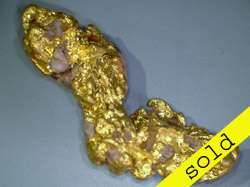 GS193 - 12.80g. 33.00mm x 16.00mm x 10.00mm |
 GS194 - 3.40g. 15.30mm x 12.40mm x 7.50mm |
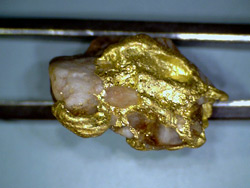 GS195 - 4.45g. 17.00mm x 13.50mm x 7.80mm CHF 311.00 |
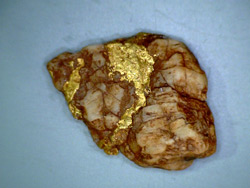 GS197 - 2.90g. 15.50mm x 13.00mm x 6.90mm CHF 174.00 |
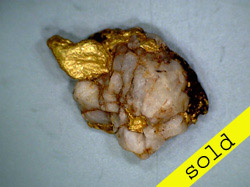 GS198 - 2.03g. 12.00mm x 9.00mm x 7.00mm |
 GS199 - 1.95g. 12.70mm x 11.00mm x 7.00mm |
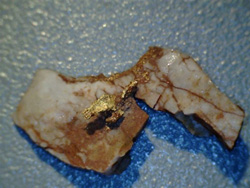 GS124 - 6.50g. 35.00mm x 20.00mm x 12.00mm / Q + L CHF 390.00 |
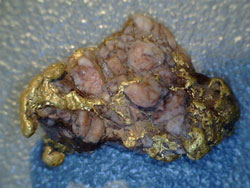 GS128 - 16.30g. 21.50mm x 17.50mm x 12.50mm / Q + H CHF 1141.00 |
 GS129 - 18.10g. 35.50mm X 20.50mm X 17.00mm / Q CHF 1267.00 |
 GS130 - 17.70g. 19.00mm X 16.00mm X 13.00mm / Q |
 GS161 - 12.98g. 24mm x 17.00mm x 12.50mm / Q CHF 908.60 |
 GS164 - 8.39g. 17.00mm x 10.50mm x 10.00mm / Q |
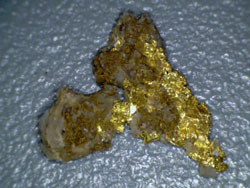 GS166 - 1.40g. 17.50mm x 12.30mm x 3.40mm / Q CHF 98.00 |
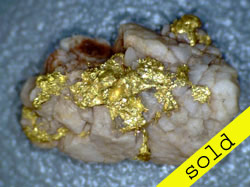 GS176 - 6.57g. 20.00mm x 12.00mm x 11.40mm / Q CHF 361.35 |
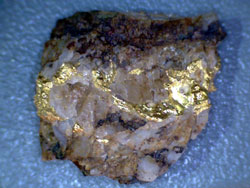 GS188 - 42.00g. 28.50mm X 26.00mm X 20.00mm Q / H CHF 2520.00 |
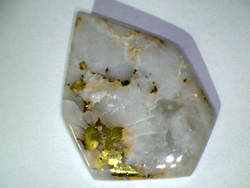 GS179c - 9.40g. 35.00mm x 24.00mm x 4.60mm / Q CHF 564.00 |
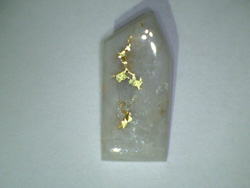 GS180c - 1.70g. 21.00mm x 10.00mm x 3.50mm / Q CHF 102.00 |
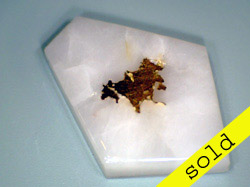 GS190c - 0.35g. 11.80mm x 8.80mm x 2.20mm CHF 15.00 |
| Minerals
attached to specimen are: Q=Quarts, H=Hematite, L=Laterite |
| All above
information subject to change. Postage not included in price. |
| ^top^ |